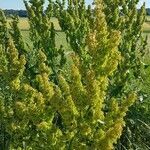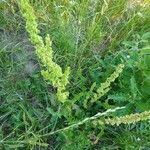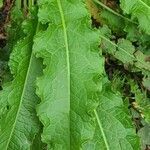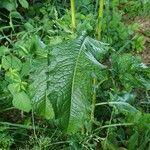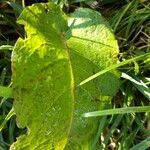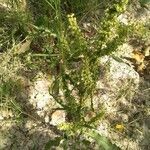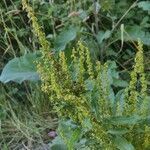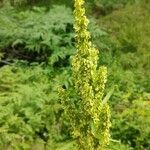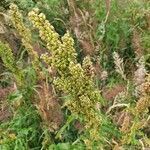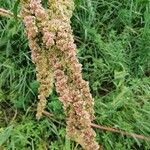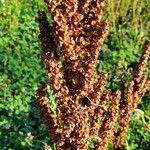Herbs perennial. Stems erect, 60-120 cm tall, robust, glabrous, grooved, branched above middle. Basal leaves: petiole 5-15 cm; leaf blade oblong-lanceolate or broadly lanceolate, 20-35 × 5-10 cm, abaxially minutely papillate along veins, adaxially glabrous, base cuneate or rounded, margin slightly undulate to weakly crisped, apex acute or subacute; cauline leaves shortly petiolate, lanceolate, small, base narrowly cuneate, apex acute; ocrea fugacious, white, membranous. Inflorescence paniculate. Flowers bisexual. Pedicels slender, articulate below middle; articulation distinctly swollen in fruit. Inner tepals enlarged in fruit; valves broadly orbicular-reniform to orbicular-cordate, 5-6 × 6-7 mm, all without tubercles, sometimes 1 valve with small indistinct tubercle, net veined, base cordate, margin entire, apex obtuse. Achenes brown, shiny, narrowly ovoid, trigonous, 2-3.5 mm. Fl. Jun-Jul, fr. Jul-Aug. 2n = 60.
Coarse perennial to 1.5 m; lower lvs narrowly oblong, broadest near the middle, tapering to an acute base; mature pedicels visibly jointed near the base; valves rotund to subreniform, 4–6 × 5–7 mm, entire or toothed, reticulate-veiny, without grains; 2n=40, 60. Native of n. Europe, sparingly intr. in our range, mainly toward the north. (R. domesticus)
A herb. It grows 1.5 m tall. The leaves are 4-30 cm long by 1-9 cm wide.
